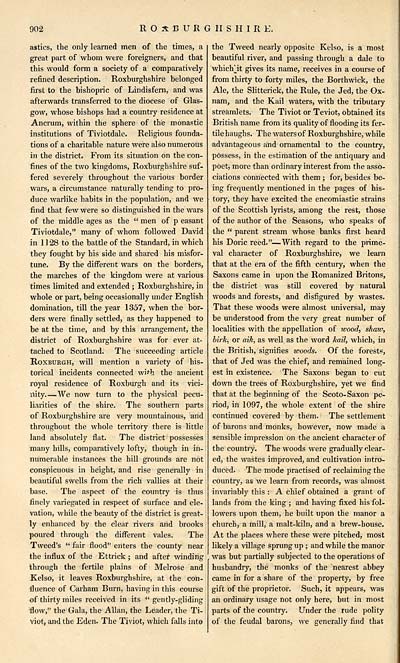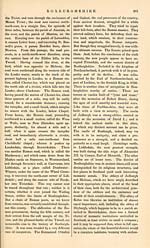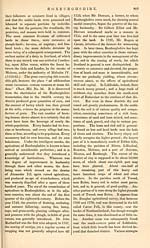Gazetteer of Scotland > Volume 2
(422) Page 902
Download files
Complete book:
Individual page:
Thumbnail gallery: Grid view | List view

902
ROXBURGHSHIRE.
astics, the only learned men of the times, a
great part of whom were foreigners, and that
this would form a society of a comparatively
refined description. Roxburghshire belonged
first to the bishopric of Lindisfern, and was
afterwards transferred to the diocese of Glas-
gow, whose bishops had a country residence at
Ancrum, within the sphere of the monastic
institutions of Tiviotdale. Religious founda-
tions of a charitable nature were also numerous
in the district. From its situation on the con-
fines of the two kingdoms, Roxburghshire suf-
fered severely throughout the various border
wars, a circumstance naturally tending to pro-
duce warlike habits in the population, and we
find that few were so distinguished in the wars
of the middle ages as the " men of p easant
Tiviotdale," many of whom followed David
in 1 1 28 to the battle of the Standard, in which
they fought by his side and shared his misfor-
tune. By the different wars on the borders,
the marches of the kingdom were at various
times limited and extended ; Roxburghshire, in
whole or part, being occasionally under English
domination, till the year 1357, when the bor-
ders were finally settled, as they happened to
be at the time, and by this arrangement, the
district of Roxburghshire was for ever at-
tached to Scotland. The succeeding article
Roxburgh, will mention a variety of his-
torical incidents connected wi*h the ancient
royal residence of Roxburgh and its vici-
nity We now turn to the physical pecu-
liarities of the shire. The southern parts
of Roxburghshire are very mountainous, and
throughout the whole territory there is little
land absolutely flat. The district possesses
many hills, comparatively lofty, though in in-
numerable instances the hill grounds are not
conspicuous in height, and rise generally in
beautiful swells from the rich vallies at their
base. The aspect of the country is thus
finely variegated in respect of surface and ele-
vation, while the beauty of the district is great-
ly enhanced by the clear rivers and brooks
poured through the different vales. The
Tweed's " fair flood" enters the county near
the influx of the Ettrick ; and after winding
through the fertile plains of Melrose and
Kelso, it leaves Roxburghshire, at the con-
fluence of Carham Burn, having in this course
of thirty miles received in its " gently-gliding
flow," the Gala, the Allan, the Leader, the Ti-
viot, and the Eden. The Tiviot, which falls into
the Tweed nearly opposite Kelso, is a most
beautiful river, and passing through a dale to
whiclrit gives its name, receives in a course of
from thirty to forty miles, the Borthwick, the
Ale, the Slitterick, the Rule, the Jed, the Ox-
nam, and the Kail waters, with the tributary
streamlets. The Tiviot or Teviot, obtained its
British name from its quality of flooding its fer-
tile haughs. The waters of Roxburghshire, while
advantageous and ornamental to the country,
possess, in the estimation of the antiquary and
poet, more than ordinary interest from the asso-
ciations connected with them ; for, besides be-
ing frequently mentioned in the pages of his-
tory, they have excited the encomiastic strains
of the Scottish lyrists, among the rest, those
of the author of the Seasons, who speaks of
the " parent stream whose banks first heard
his Doric reed." — With regard to the prime-
val character of Roxburghshire, we learn
that at the era of the fifth century, when the
Saxons came in upon the Romanized Britons,
the district was still covered by natural
woods and forests, and disfigured by wastes.
That these woods were almost universal, may
be understood from the very great number of
localities with the appellation of ivood, shaw,
birk, or aik, as well as the word kail, which, in
the British, signifies woods. Of the forests,
that of Jed was the chief, and remained long-
est in existence. The Saxons began to cut
down the trees of Roxburghshire, yet we find
that at the beginning of the Scoto- Saxon pe-
riod, in 1097, the whole extent of the shire
continued covered by them. The settlement
of barons and monks, however, now made a
sensible impression on the ancient character of
the country. The woods were gradually clear-
ed, the wastes improved, and cultivation intro-
duced. The mode practised of reclaiming the
cOuntry, as we learn from records, was almost
invariably this : A chief obtained a grant of
lands from the king ; and having fixed his fol-
lowers upon them, he built upon the manor a
church, a mill, a malt-kiln, and a brew-house.
At the places where these were pitched, most
likely a village sprung up ; and while the manor
was but partially subjected to the operations of
husbandry, the monks of the nearest abbey
came in for a share of the property, by free
gift of the proprietor. Such, it appears, was
an ordinary usage not only here, but in most
parts of the country. Under the rude polity
of the feudal barons, we generally find that
ROXBURGHSHIRE.
astics, the only learned men of the times, a
great part of whom were foreigners, and that
this would form a society of a comparatively
refined description. Roxburghshire belonged
first to the bishopric of Lindisfern, and was
afterwards transferred to the diocese of Glas-
gow, whose bishops had a country residence at
Ancrum, within the sphere of the monastic
institutions of Tiviotdale. Religious founda-
tions of a charitable nature were also numerous
in the district. From its situation on the con-
fines of the two kingdoms, Roxburghshire suf-
fered severely throughout the various border
wars, a circumstance naturally tending to pro-
duce warlike habits in the population, and we
find that few were so distinguished in the wars
of the middle ages as the " men of p easant
Tiviotdale," many of whom followed David
in 1 1 28 to the battle of the Standard, in which
they fought by his side and shared his misfor-
tune. By the different wars on the borders,
the marches of the kingdom were at various
times limited and extended ; Roxburghshire, in
whole or part, being occasionally under English
domination, till the year 1357, when the bor-
ders were finally settled, as they happened to
be at the time, and by this arrangement, the
district of Roxburghshire was for ever at-
tached to Scotland. The succeeding article
Roxburgh, will mention a variety of his-
torical incidents connected wi*h the ancient
royal residence of Roxburgh and its vici-
nity We now turn to the physical pecu-
liarities of the shire. The southern parts
of Roxburghshire are very mountainous, and
throughout the whole territory there is little
land absolutely flat. The district possesses
many hills, comparatively lofty, though in in-
numerable instances the hill grounds are not
conspicuous in height, and rise generally in
beautiful swells from the rich vallies at their
base. The aspect of the country is thus
finely variegated in respect of surface and ele-
vation, while the beauty of the district is great-
ly enhanced by the clear rivers and brooks
poured through the different vales. The
Tweed's " fair flood" enters the county near
the influx of the Ettrick ; and after winding
through the fertile plains of Melrose and
Kelso, it leaves Roxburghshire, at the con-
fluence of Carham Burn, having in this course
of thirty miles received in its " gently-gliding
flow," the Gala, the Allan, the Leader, the Ti-
viot, and the Eden. The Tiviot, which falls into
the Tweed nearly opposite Kelso, is a most
beautiful river, and passing through a dale to
whiclrit gives its name, receives in a course of
from thirty to forty miles, the Borthwick, the
Ale, the Slitterick, the Rule, the Jed, the Ox-
nam, and the Kail waters, with the tributary
streamlets. The Tiviot or Teviot, obtained its
British name from its quality of flooding its fer-
tile haughs. The waters of Roxburghshire, while
advantageous and ornamental to the country,
possess, in the estimation of the antiquary and
poet, more than ordinary interest from the asso-
ciations connected with them ; for, besides be-
ing frequently mentioned in the pages of his-
tory, they have excited the encomiastic strains
of the Scottish lyrists, among the rest, those
of the author of the Seasons, who speaks of
the " parent stream whose banks first heard
his Doric reed." — With regard to the prime-
val character of Roxburghshire, we learn
that at the era of the fifth century, when the
Saxons came in upon the Romanized Britons,
the district was still covered by natural
woods and forests, and disfigured by wastes.
That these woods were almost universal, may
be understood from the very great number of
localities with the appellation of ivood, shaw,
birk, or aik, as well as the word kail, which, in
the British, signifies woods. Of the forests,
that of Jed was the chief, and remained long-
est in existence. The Saxons began to cut
down the trees of Roxburghshire, yet we find
that at the beginning of the Scoto- Saxon pe-
riod, in 1097, the whole extent of the shire
continued covered by them. The settlement
of barons and monks, however, now made a
sensible impression on the ancient character of
the country. The woods were gradually clear-
ed, the wastes improved, and cultivation intro-
duced. The mode practised of reclaiming the
cOuntry, as we learn from records, was almost
invariably this : A chief obtained a grant of
lands from the king ; and having fixed his fol-
lowers upon them, he built upon the manor a
church, a mill, a malt-kiln, and a brew-house.
At the places where these were pitched, most
likely a village sprung up ; and while the manor
was but partially subjected to the operations of
husbandry, the monks of the nearest abbey
came in for a share of the property, by free
gift of the proprietor. Such, it appears, was
an ordinary usage not only here, but in most
parts of the country. Under the rude polity
of the feudal barons, we generally find that
Set display mode to: Large image | Transcription
Images and transcriptions on this page, including medium image downloads, may be used under the Creative Commons Attribution 4.0 International Licence unless otherwise stated. ![]()
| Gazetteers of Scotland, 1803-1901 > Gazetteer of Scotland > Volume 2 > (422) Page 902 |
|---|
| Permanent URL | https://digital.nls.uk/97435886 |
|---|
| Description | Volume II: Glenbanchor to Zetland. |
|---|---|
| Attribution and copyright: |
|
| Description | By Robert Chambers and William Chambers. Glasgow: Blackie & Son, 1838. 2 volumes. |
|---|---|
| Shelfmark | NF.1461.g.7 |
| Additional NLS resources: | |

